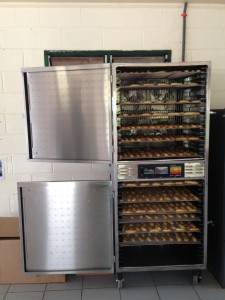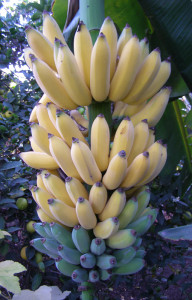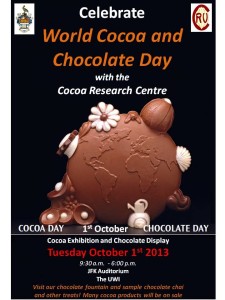- Secretary of Agriculture tours Ft Collins genebank. With video goodness.
- Which genebank I’m sure follows the Genebank Standards for Plant Genetic Resources for Food and Agriculture. With video goodness.
- Prince of Wales sows organic rice. In white suit. With video goodness.
- The story of indigo. No video, but lots of photos.
- Sardinian blood soup. No video, but one photo. Which is more than enough.
- Wanna watch Seeds of Time? Here’s where. Includes much on Svalbard, of course. And a bit on USDA wild potato collecting. I plead the fifth.
- So there’s a second banana genome? Thankfully no video.
- “We are only using the tip of the iceberg.” Rice genetic resources, that is. Could easily have had a video.
- Face palm oil.
- Photo essay on the bazaars of Central Asia.
Nibbles: Soil testing kit, Sustainable farming, Coffee and climate change, BGI genebank, Bamboo genebank, Genebank management, India’s malnutrition, Phenotyping conference, CIP genebank video, CG impact, Feed the World
Luigi went on a three-week trip, and all he came back with was this:
- A new soil testing kit? Really?
- Ok, how about a SciDev Spotlight featurette on sustainable farming? No? Well, can I tempt you with the British Ecological Society on agroecology then?
- Oh, I bet this thing on coffee and climate change will hit home.
- I’m pretty sure news of yet another Chinese genebank (of sorts) won’t.
- Pssst. Got room for a new bamboo genebank too?
- They’ll need a genebank management system, won’t they? GRIN and bear it.
- News too of hunger and malnutrition in India, by Indians, for … er …
- Phenotyping conference, anyone? Anyone at all? Some EU breeders will no doubt be there. And some of them at least will find a new map of water risk useful in their work.
- And to end with, Al Jazeera on the CIP potato genebank. You heard me.
- As you were, there’s the CGIAR Knowledge Day too, all about delivery and impact. I wonder if the genebanks will feature…
- Not so fast, there’s also a live webcast of the conference Feeding the World without Consuming the Planet that awaits you.
Local Samoan banana variety a hit in NZ
 My friend and former colleague Stephen Hazelman of the Secretariat of the Pacific Community (SPC) has been telling me about his new toy, a drier that an NGO in Samoa called Women in Business Development Inc. is using to process a local banana variety for export to New Zealand. You can see it on the left, thanks to Stephen. Drying overcomes the need for quarantine treatments in NZ. They harvest from certified organic farmers, ripen the fruits for 4-7 days, peel, soak in lime juice to stop blackening, then put in the drier for 15-20 hours, cool and pack in nice yellow 50g packages for export. They are also looking at teas, cinnamon, other fruits like pineapple and mangos, and also vegetables.
My friend and former colleague Stephen Hazelman of the Secretariat of the Pacific Community (SPC) has been telling me about his new toy, a drier that an NGO in Samoa called Women in Business Development Inc. is using to process a local banana variety for export to New Zealand. You can see it on the left, thanks to Stephen. Drying overcomes the need for quarantine treatments in NZ. They harvest from certified organic farmers, ripen the fruits for 4-7 days, peel, soak in lime juice to stop blackening, then put in the drier for 15-20 hours, cool and pack in nice yellow 50g packages for export. They are also looking at teas, cinnamon, other fruits like pineapple and mangos, and also vegetables.
 The variety involved is a small, sweet, high-altitude local type called Misi Luki. You can read all about its history and characteristics, and also see some pictures here. ((Thanks to Encanto Farms for the photo.)) It’s listed in ProMusa’s checklist of banana cultivars as an AAB type. If the banana were a neglected or underutilized species (NUS), Stephen could have reported on this under the “upgrading value chains” theme of the recent conference in Accra. But of course what works for weird and wonderful local landraces of the staples could also work for NUS. No news on whether Misi Luki is on any gourmet menus. But that’s another story…
The variety involved is a small, sweet, high-altitude local type called Misi Luki. You can read all about its history and characteristics, and also see some pictures here. ((Thanks to Encanto Farms for the photo.)) It’s listed in ProMusa’s checklist of banana cultivars as an AAB type. If the banana were a neglected or underutilized species (NUS), Stephen could have reported on this under the “upgrading value chains” theme of the recent conference in Accra. But of course what works for weird and wonderful local landraces of the staples could also work for NUS. No news on whether Misi Luki is on any gourmet menus. But that’s another story…
Happy World Chocolate Day!
 The previous post about the International Treaty on ITPGRFA allows me to segue seamlessly to today’s World Cocoa and Chocolate Day event at the University of the West Indies in Trinidad. Seamlessly, I hear you ask? Stretching a point, surely. Well, no, because everyone knows that the International Cocoa Genebank, maintained at said institution’s Cocoa Research Centre, is one of the collections which are available in the Multilateral System of the Treaty under its Article 15. You can tour the place, you know. Anyway, I’m hoping one of my inside people will come through with some photos of the celebrations. Stay tuned.
The previous post about the International Treaty on ITPGRFA allows me to segue seamlessly to today’s World Cocoa and Chocolate Day event at the University of the West Indies in Trinidad. Seamlessly, I hear you ask? Stretching a point, surely. Well, no, because everyone knows that the International Cocoa Genebank, maintained at said institution’s Cocoa Research Centre, is one of the collections which are available in the Multilateral System of the Treaty under its Article 15. You can tour the place, you know. Anyway, I’m hoping one of my inside people will come through with some photos of the celebrations. Stay tuned.
Nibbles: Lathyrism, Ancient maize, Sustainable cacao, Bioversity on agrobiodiversity, Weird fruits, Carrot seed, Palm wine, Buckwheat, Halophytes issue, Weird(ish) crops, Urban malnutrition, Old oranges, Molasses, Indian tree institute
- An ODAP detective story.
- Ancient maize gets a map.
- Diversity is the key to sustainable cacao.
- New Bioversity DG answers the tough questions.
- Be the first on your block with an unusual fruit tree.
- How to grow awesome carrot seed.
- The hard life of Nigerian wine tappers.
- Bringing back buckwheat in Bhutan.
- Annals of Botany to do halophytes.
- Come down to earth with the realization that most people have never heard of cowpea and cassava. Would they have heard of black-eyed peas and tapioca, though?
- Big report on urban malnutrition. Maybe cassava (see above) can help?
- The last orange grove in the San Fernando Valley. No word on what the variety might be.
- All about molasses.
- Indian tree breeding institute, and accompanying genebank, get a write-up.
- Yes, I know that I could have done a better job of pointing out the connections among some of these things, but it’s been a long week.